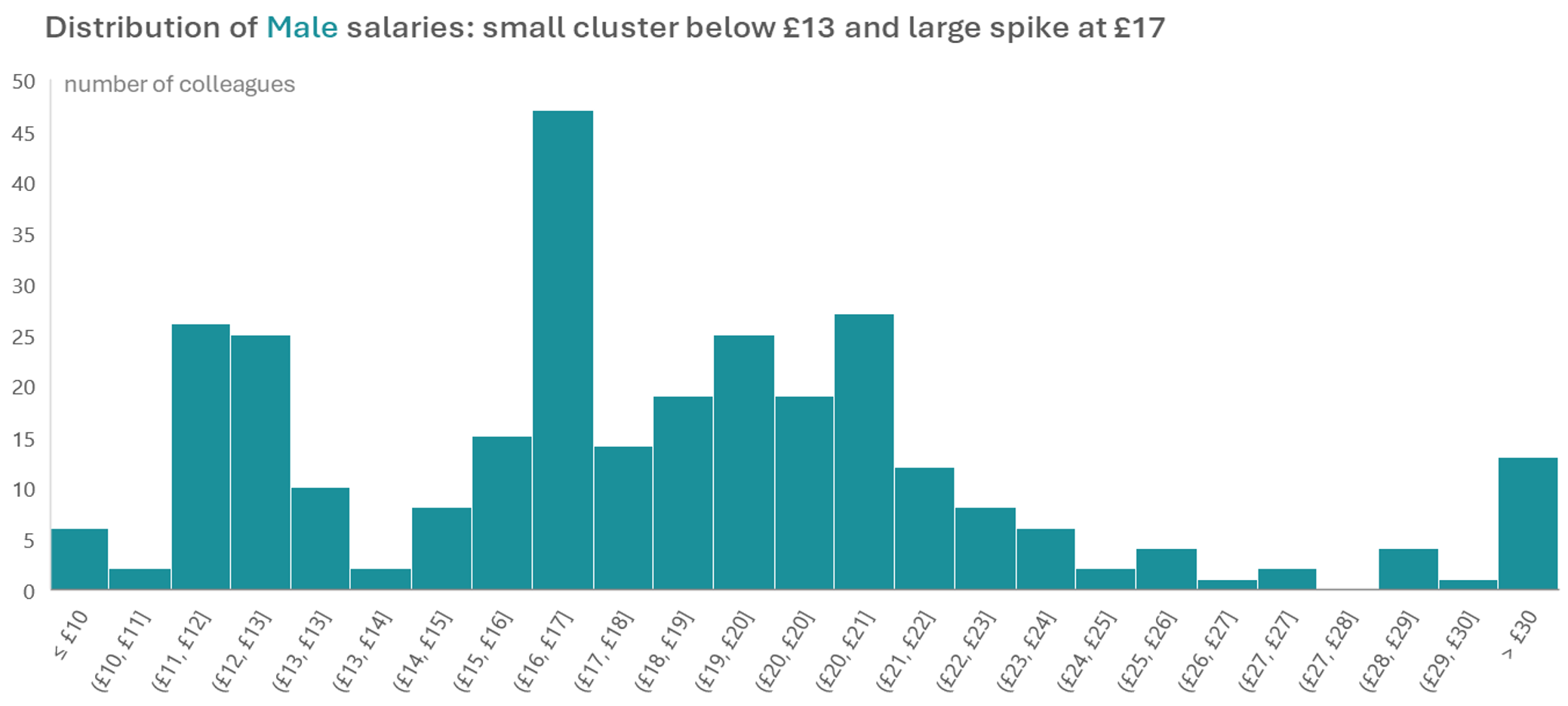Connexus Gender Pay Gap Report 2023-2024

Foreword
At Connexus our aim continues to be to create a great place to work, with a clear focus on ensuring our customers are serviced by a high performing, highly motivated and diverse team, equipped with the right skills and capability. Our PRIDE values of passionate, respectful, involving, determined and effective remain at the heart of how we work and our commitment to ensuring equality, diversity and inclusion in our workplace.
As part of our on-going commitment to close our gender pay gap, we continue to ensure across all our strategies and policies, that opportunities to reduce the gender pay gap are identified and promoted to ensure we build an open and inclusive workplace.
Since 2017, all UK organisations with more than 250 employees have been required to publish their gender pay gap. Connexus has seen changes to its gender pay gap during this period, as detailed within this report, however, whilst positive steps have been taken, we still have some way to go, this year reporting a decrease in our median gender pay gap but an increase in the mean gender pay gap.
We take time to understand what this data tells us and at the end of this report set out our approaches to continue to reduce the gap and increase the diversity of our workforce.
Kate Smith, CEO
How the Gender Pay Gap is measured
The Gender Pay Gap is the calculated difference between the average (mean and median) earnings of males and females across our workforce. This approach enables transparency about gender pay differences and enables positive actions. This is different to equal pay and a gender pay gap can exist even when equal pay is in place.
As required in the Equality Act 2010 (Specific Duties and Public Authorities) Regulations 2017, Connexus is publishing our:
- Mean and median gender pay gap
- Mean and median gender bonus gap
- Proportion of female and male colleagues receiving bonuses
- Proportion of female and male colleagues in each quartile of our pay structure
The mean pay gap is the percentage difference in the mean average pay between all male and female employees in the organisation. We calculate the mean by summing up all the salaries and dividing by the number of employees.
The median pay gap is the percentage difference in the median average pay between all male and female employees within the organisation. We calculate the median by ordering all employees pay from highest to lowest and finding the middle.
Pay quartiles shows the percentage of males and females in each pay quartile. We develop these by ordering all employees pay from highest to lowest and splitting them into 4 equal groups.
Published data
Connexus published this data on the Gender Pay Gap Service on the 13th March 2024, ahead of the deadline of 4th April 2024. You can view our published data on the Gov.UK Gender Pay Gap Service
The Gender Pay Gap at Connexus

Connexus employed 536 colleagues on the 5th April 2023. Of our 536 colleagues, 55.6% (298) were male and 44.4% (238) were female, or a difference of 11.2%. This compares to a difference of 8.6% in April 2022.

Mean pay gap
Males at Connexus were paid a mean difference of £1.77 more per hour than females. This is a gender pay gap of 9.7% and is £0.45 more per hour difference than our previous year’s reported gap (£1.34). This means our Mean Pay Gap has increased for the second year in a row. The gap of 9.7% compares to 8% in 2022, 1.2% in 2021, 8.4% in 2020 and 9.1% in 2019.
Comparative mean hourly pay

There has been a mean increase in hourly pay for both genders compared to 2022. Males were paid £1.68 more (£18.33 compared to £16.65 in 2022), while females were paid £1.25 more (£16.56 compared to £15.31 in 2022). This equates to an increase of 10.1% for males, and 8.2% for females, compared to increases of 11.3% for males and 3.6% females in 2022.
Distribution of hourly salaries by gender in 2023
Each vertical line represents a single colleague's salary. Darker sections show that there are more people at that salary level.

Figure 3 gives an indication of the spread of salaries across the salary ranges split by gender. The density of the lines at different pay levels indicates the number of people earning at that level. Darker, more congested areas suggest a higher concentration of employees at that salary level.
The overall distribution of pay rates is wide for both genders, but the spread is more pronounced for males, indicating a larger variance in male employees' pay rates. There is a higher concentration of females in lower-paid roles and a higher concentration of males in higher-paid roles, which can be a contributing factor to the gender pay gap.

Median
Males at Connexus were paid a median difference of £2.67 more than females in hourly pay. This is a gap of 15.5% and is a £0.36 reduction compared to our previous year’s reported gap (£3.02). Our Median Pay Gap of 15.5% is a 3.3% drop compared to the median gap of 18.8% in 2022. Previous years saw a median gap of 7.8% in 2021, 14.2% in 2020 and 7.3% in 2019.
There have been median increases in hourly pay for both genders compared to 2022. Males were paid £1.11 more (£17.19 in 2023 compared to £16.08 in 2022), while females were paid £1.47 more (£14.52 in 2023 compared to £13.74 in 2022). This represents a 6.9% increase for males and 11.3% year on year increase for females.

Observations about the distribution of salaries
It seems counter-intuitive that the gap between the mean (average) pay has increased, whereas the gap between the median (mid-point) has decreased. The mean is influenced by the extreme values at either end of the data distribution, while the median gives a better sense of the central tendency when data is skewed. Therefore, a higher mean gap together with a reduced median gap suggests that while pay equity may be improving for the majority (as indicated by the median), the extremes (especially the upper end) are diverging more than before.



Figure 6 illustrates the distribution of hourly pay rates for male and female employees, with both genders’ rates overlaid. This highlights the distribution and overlap of pay rates between genders, providing a clear view of how each gender's pay rates are spread across the organisation.
Note: The axis along the bottom has been truncated at £60 per hour to exclude many of the outliers and this helps us focus on the most common pay rates.
Mean and median bonus pay gaps
As a result of a review of terms and conditions in January 2020 no employees at Connexus receive a bonus and therefore we make a nil return for this element of the report.
Pay quartiles by gender

Our Lower Quartile range of hourly pay is £1.94 to £12.97.
The actual low value of £1.94 is skewed by our Mobile Responders service and zero hours contracts. Connexus adhered to the government standards of apprentice and National Living/Minimum wage. During 2022, Connexus moved to paying the Real Living Wage across the organisation.
- Of colleagues in the lower pay quartile, 48.5% were male and 51.5% were female, or a difference of 3%.
- The ratio of males in the lower quartile had previously increased from 36.0% in 2020 to 50.8% in 2021, and 51.6 in 2022.
- Females in the lower quartile had seen a decrease from 64.0% in 2020 to 48.4% in 2022 before rising this year.
Our Lower Middle Quartile range of hourly pay is £12.97 to £16.89.
- Of colleagues in the lower middle pay quartile, 64.2% were female and 35.8% were male, or a difference of 28.4%.
- In 2022, there were 30.8% more males than females in the lower middle quartile (65.4% male and 34.6% female).
Our Upper Middle Quartile range of hourly pay is £16.89 to £19.90.
- Of colleagues in the upper middle pay quartile there were 68.7% males and 31.3% females, or a difference of 37.4%.
- This is 15.4% more than in 2022 (males 61.4%, females 38.6%), and almost 30% more than the gap in 2021 (males 59.0%, females 41.0%)
Our Upper Quartile range of hourly pay is £19.91 to £90.21.
- Of colleagues in the upper pay quartile there were 69.4% males and 30.6% females, or a difference of 38.8%.
This means the gap has reduced slightly from the 2022 figure of 40.2% (males 70.1%, females 29.9%) but is still significantly higher than the 2021 difference of 13.2% (males 56.6%, females 43.4%).

Understanding and closing our gender pay gap
According to a report by the Fawcett Society, at the current rate of change the UK gender pay gap will not close until 2051, with the TUC reporting that it is falling at an average of 0.7 percentage points per year for the past five years. To change this, organisations need to better understand the data behind their gender pay gap and be proactive in working to address this.
Connexus continues to take proactive action and for this to be effective we spend time understanding where we need to make improvements in the context of our organisation and the areas in which we operate.
- Connexus has a number of different roles and some of those impact our gender pay gap more than others. For example, Trade colleagues make up 28% of our total workforce and 99% of trade colleagues are male, an area we need to address. We offer several support related services, and these are predominantly delivered by female colleagues. Of those roles with ‘support’ in the job description 57 out of the 65 colleagues (88%) are female. Societal norms and value placed on certain roles continues to have an impact on gender imbalances in these roles, as well as the pay. While this creates a barrier to the pace that we may be able to enact change, we are proactive in the mechanisms we have within our control.
- Our approach to pay ensures we have equal pay across our roles, and benchmarking these roles ensures we remain competitive. Where we are able, we seek to recognise and reward at a higher level, for example, we commit to paying at least the Real Living Wage to all of our employees and apprentices. However, a factor which influences our gender pay gap is the type of roles that are eligible for overtime. These roles, such as Trades, are predominantly held by males, which is a factor in the widening of the gap. Over the next 12 months we will review this and understand how changes to terms and conditions of employment might address this.
- New TUC analysis for 2023 finds that more than 1.46 million women are kept out of the labour market because of their caring responsibilities. This compares to around 230,000 men. Women in their 30s are the hardest hit but at every age, from the start through to the end of their careers, women are more likely than men to have to drop out of paid work due to caring commitments. As part of removing barriers to employment and progression, Connexus continues to promote hybrid, flexible and part-time working options in all of the roles it is able to.
- We continue to develop policies and ways of working that support and encourage women in employment and in 2023 set up a Menopause peer-led support group and developed a Menopause policy, training and guidance. As part of our continued review into our ways of working, we will look at where else we can influence our policies to support a better gender balance in roles across our organisation.
- We ensure all of our policies, strategies and projects are subject to an equality impact assessment to ensure fairness.
- Our job adverts include an inclusivity statement which encourages applications from underrepresented groups to apply for our roles and we advertise on a variety of job boards. We’ve trained our managers on unconscious bias and as part of addressing the gap we will complete targeted recruitment campaigns.
- Our analysis shows that we have an imbalance of genders in certain roles within our business and to address this we will seek; more males in our Officer level roles, including Housing Officers, more females in IT, more females in roles within our repairs and assets teams for roles including Trades, Surveyors and Supervisors, more females in leadership roles and, more males within Support Services roles.
- As part of working to address these imbalances we will look at how we can attract more males or females and will work to understand and address any barriers to employment. This will include reviewing our terms and conditions, understanding working practices which may be creating barriers, looking at targeted recruitment for any vacancies, working on our own career pathways and succession plans, and making best use of apprenticeships to support with career development and change.
Actions we will take
We are committed to working to close the Gender Pay Gap and our actions below highlight how we will be proactive in this. We will monitor progress against our actions through our Equality, Diversity and Inclusion plan.
- Action: We will carry out proactive targeted recruitment campaigns aimed at attracting more female trade colleagues
- Action: We will carry out proactive targeted recruitment campaigns aimed at attracting more males in relevant support roles
- Action: We will increase the number of apprenticeship opportunities and routes to support access to employment and career change and better understand where these could support with closing the Gender Pay Gap
- Action: We will review terms and conditions for roles within our business with the aim of removing barriers to pay equity and progression
- Action: We will develop an organisational design strategy which promotes greater opportunities for diversity within our workforce
- Action: We will develop a diversity action plan and calculate our ethnicity pay gap
- Action: We will review approach to hybrid working for all roles within Connexus
- Action: We will develop our approach to career pathways, talent management and succession planning within Connexus
- Action: We will commit to being a Menopause friendly employer and explore relevant accreditations